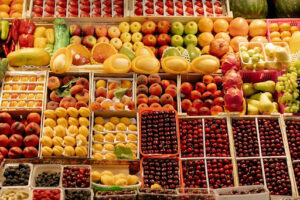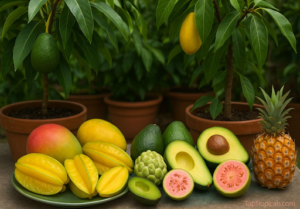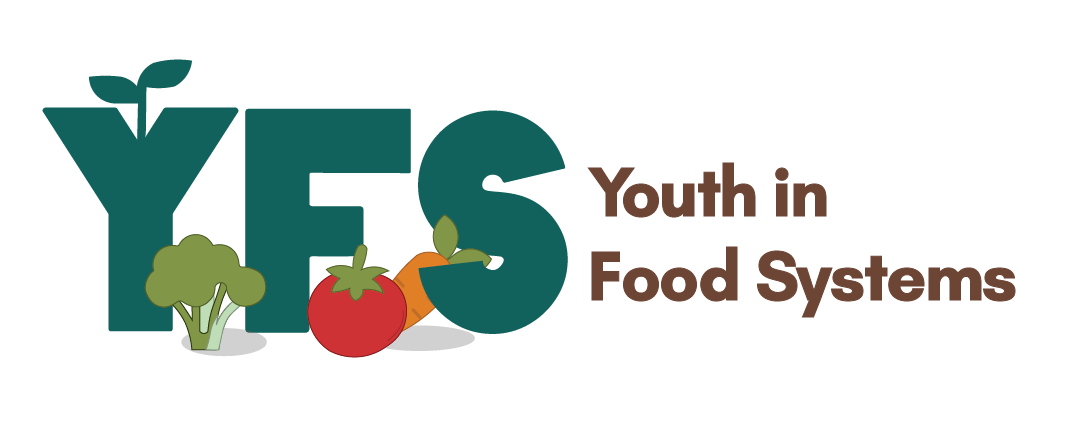RETHINK YOUR PLATE:
You Should Be Eating Food In Season, And Here’s Why
Written by: Ruth Fisseha
Edited by: Mannat Malhan
Designed by: Eleanor Jeavons
Published by: Rayna Almas
Have you ever wondered why certain fruits and vegetables only appear in grocery stores or farmers’ markets at specific times of the year? Why is watermelon so plentiful in the summer but almost impossible to find in winter? The answer lies in the fascinating world of seasonal food.

What Does “Seasonal Food” Mean?
Seasonal food refers to fruits, vegetables, and other crops that naturally ripen and become ready for harvest during a specific time of year. This timing depends on climate, daylight, temperature, and growing conditions.
Some examples of seasonal food in Ontario include:
- Watermelon, corn, tomatoes, and berries in the summer.
- Grapes, broccoli, pumpkin, and radishes in the fall.
- Beets, cabbage, pears, and garlic in the winter.
- Red onions, spinach, asparagus, and beets in the spring.
These foods grow best when seasonal conditions suit their environmental needs, resulting in a tastier, more nutritious harvest. Now, not to fret—this isn’t to say that out-of-season fruit isn’t nutritious, but rather that it’s usually grown abroad and picked before reaching ripeness, allowing it to not spoil before being sold in our grocery stores. Furthermore, produce tends to lose more nutrition the longer it’s left sitting out, so out-of-season fruit is only a fraction as nutritious as its seasonal counterpart.
Sure, you can find strawberries in the winter, but the juiciest ones you’ve enjoyed were probably grown in the province, weren’t they?
Why is Food Seasonal?
Several factors influence a crop’s ability to truly flourish, including evolution, environmental conditions, and time.
Evolution:
 Plants have evolved to grow, flower, and fruit in sync with the seasons to maximize survival and reproduction. Warm weather and longer days help many plants grow quickly, while cooler seasons signal dormancy or slower growth. During warm seasons with long daylight hours, plants can absorb more sunlight and therefore photosynthesize more efficiently, producing the energy needed for rapid growth. However, some plants have evolved to withstand chillier, less sunny conditions, but don’t grow as well in the summer as a consequence. Many leafy greens are prone to bolting—a process in which a plant shifts its growth from vegetative to reproductive, producing flowers or seeds instead of leaves and stems. This can happen when the crop is exposed to too much heat. Bolting reduces the quality of the plant’s edible parts and can sometimes render the entire crop inedible. The main point is that plants can only evolve to withstand so many conditions, which is why they’re only grown in specific seasons.
Plants have evolved to grow, flower, and fruit in sync with the seasons to maximize survival and reproduction. Warm weather and longer days help many plants grow quickly, while cooler seasons signal dormancy or slower growth. During warm seasons with long daylight hours, plants can absorb more sunlight and therefore photosynthesize more efficiently, producing the energy needed for rapid growth. However, some plants have evolved to withstand chillier, less sunny conditions, but don’t grow as well in the summer as a consequence. Many leafy greens are prone to bolting—a process in which a plant shifts its growth from vegetative to reproductive, producing flowers or seeds instead of leaves and stems. This can happen when the crop is exposed to too much heat. Bolting reduces the quality of the plant’s edible parts and can sometimes render the entire crop inedible. The main point is that plants can only evolve to withstand so many conditions, which is why they’re only grown in specific seasons.
Climate and Soil:
Beyond just temperature, plants need a very specific combination of environmental factors to grow well, and these factors fluctuate with the seasons. Different crops need specific conditions—temperature, moisture, and soil nutrients—that only occur at certain times. For example, strawberries need warm days and cool nights, which happen mostly in late spring and early summer.
Pollination and Growth Cycles:
Many plants rely on pollinators, like bees, that are active only during certain seasons. In addition, fruit development takes time, so harvesting happens when the produce is fully ripe.
Why Should You Eat Seasonal Food?
Better Taste and Nutrition
As previously mentioned, foods harvested in their natural season are fresher and more flavourful because they’re allowed to fully ripen on the plant and don’t need to be transported overseas before reaching our homes. Nutrients like vitamins and antioxidants tend to be higher as well, making seasonal food healthier.
Cost-Effective
When produce is in season locally, it’s more abundant and easier to grow, which usually means lower prices. Imported or out-of-season foods need extra transport and storage costs, which add up quickly.
Environmental Benefits
Eating seasonally reduces the need for energy-intensive greenhouses, long-distance shipping, and heavy refrigeration. This means less pollution and a smaller carbon footprint.
Supports Local Farmers and Economy
Seasonal food often comes from local farms, helping to keep small-scale agriculture alive and your local economy thriving.
Variety and Health
Eating seasonally encourages you to enjoy a variety of foods throughout the year, providing a wide range of beneficial nutrients that are essential for good health. It can inspire creativity in cooking, too!

Final Thoughts
In a way, seasonal food acts as more of a “life hack” than just a calendar—it provides a glimpse into nature’s cycles and shows you exactly how to eat smarter, tastier, and more sustainably. The next time you’re at the market, try picking up something ripe and ready right now; your taste buds, your health, and the planet will thank you!
Bibliography
Works Cited
“Are Your Plants Bolting? Here’s What That Means & What to Do • Gardenary.” Gardenary.com, 2024, www.gardenary.com/blog/are-your-plants-bolting-heres-what-that-means.
“Availability Guide.” Ontario.ca, 2024, www.ontario.ca/foodland/page/availability-guide#winter.
Cottonbro Studio. “Fruits on a Food Market · Free Stock Photo.” Pexels, 6 Oct. 2021, www.pexels.com/photo/fruits-on-a-food-market-9811160/. Accessed 12 Sept. 2025.
Foundation, National Breast Cancer. “4 Reasons to Eat Seasonally This Spring.” National Breast Cancer Foundation, 21 Mar. 2023, www.nationalbreastcancer.org/blog/4-reasons-to-eat-seasonally-this-spring/.
“How to Prevent Bolting in Vegetable Crops.” GrowVeg, www.growveg.com/guides/how-to-prevent-bolting-in-vegetable-crops/.
Merschel, Michael. “The Ripe Stuff: Why Seasonal Eating Can Be a Healthy Delight.” Www.heart.org, 12 July 2024, www.heart.org/en/news/2024/07/12/why-seasonal-eating-can-be-a-healthy-delight.

